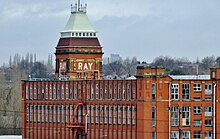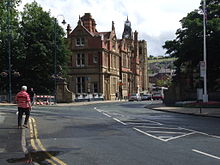Stalybridge
[2] The wealth created in the 19th century from the factory-based cotton industry transformed an area of scattered farms and homesteads into a self-confident town.Stalybridge was among the first wave of towns to establish a Mechanics' Institute with a view to educating the growing number of workers.Although the People's Charter was praised at public meetings, the resolutions that were passed at these were in almost all cases merely for a restoration of the wages of 1820, a ten-hour working day, or reduced rents.In October 1862, a meeting was held in Stalybridge Town Hall that passed a resolution blaming the Confederate States of America and their actions in the American Civil War, rather than U.S. blockades of seaports, for the cotton famine in Lancashire.Records of this man indicate that his sole interest was to sow the seeds of dissent between Roman Catholics, who by this time had grown to significant proportions, and Protestants.In his lectures to the public, "pretending to expose the religious practices of the Roman Catholic Church", he became a master at whipping up a crowd into a frenzy.Stalybridge Borough Band was formed in March 1871, holding its first rehearsals and meetings at the Moulder's Arms, Grasscroft Street, Castle Hall.Ada Summers photo appeared in the weekly journal Great Thoughts, 5 June 1920, alongside an interview on "The First Woman JP" on her work.She was an active suffragist and Liberal and used her wealth and position to support a number of schemes designed to improve conditions in the town.New applications of engineering principles, the manufacture of rubber goods, plastics, chemicals and packaging materials were all introduced, as well as the addition of synthetic fibres to the textile trade, reducing unemployment.The early 1970s saw the development of private semi-detached and detached housing estates, particularly in the Mottram Rise, Hough Hill, Hollins and Carrbrook areas; the redevelopment of Castle Hall was also completed.The cinema has since been converted to become Rififi Nightclub and Amber Lounge Bar & Restaurant, which itself was closed down late in 2012 after two violent incidents on the same night.[29] In 1828, a body of improvement commissioners was established to administer a newly-defined Stalybridge district, which straddled the townships of Dukinfield, Stayley, and Ashton-under-Lyne.Between the passing of the Second Reform Act in 1867, and the general election of 1918, the town was represented in its own right through the Stalybridge Borough constituency.Boar Flat is part of the Dark Peak Site of Special Scientific Interest, as classified by Natural England.Firstly, the Brushes Valley, with its four reservoirs running up into the Pennine Moors, and secondly Carrbrook, lying in the shadow of Buckton Castle.The country park affords views of the Cheshire Plain, Jodrell Bank and on very clear days the mountains of Snowdonia.[51] In 1865, local mill owner Abel Harrison died and his home, Highfield House, and its extensive grounds, on the border with Ashton were bought by the two towns.Also, British art of the 19th and 20th centuries is represented by artists such as John Linnell, Richard Parkes Bonington, George Price Boyce, Burne-Jones, Mark Gertler and Duncan Grant.M. John Harrison describes Stalybridge in his short story "The Ice Monkey" as a place "where nothing is clear-cut and there is neither town nor country, just a grim industrial muddle of the two".Stalybridge has the public house with the longest name in Britain – The Old Thirteenth Cheshire Astley Volunteer Rifleman Corps Inn, which closed in June 2016 but reopened in April 2019 – and also the one with the shortest, Q.[66] The railway station is one of the last in Britain to retain its original buffet, the 1998 refurbishment of which won awards from CAMRA and English Heritage.The Stockport to Stalybridge Line only now carries two parliamentary services, one in each direction on Saturday mornings, to avoid closing the intermediate stations Reddish South and Denton.The majority of services that serve the bus station are run by Stagecoach Manchester (most of which under the Bee Network) whilst other operators include Nexus Move and Stotts Tours.The club reached the 1st round of the FA Cup in the 1900/1901 season[80] and its players included Arthur Wharton and Herbert Chapman.In the same year he asserted his right to the title of the champion swimmer of the world beating three competitors in the 600 yards (550 m) championship race at Doncaster, covering the distance in 6 minutes 30 seconds to win by a length and a half.After the Industrial Revolution, the rising population and the settlement of people from various parts of the country meant that Stalybridge became a centre for a wide range of denominations and sects.The foundation stone of the parish church of St Paul's, Staley, was laid by Stapleton Stapleton-Cotton, 1st Viscount Combermere on 2 February 1838.In 2011 an estimated repair bill of £250,000 led to a decision to close St Raphael's; a final Mass was held on 14 July 2011, and although it was Grade II listed in 2011,[88] its future is now "uncertain".[3] Stalybridge Congregational Church is to be found in a modern building on Baker Street, just off Acres Lane, behind the Organ public house.
























Greater ManchesterOS grid referenceMetropolitan boroughTamesideMetropolitan countyRegionNorth WestCountryEnglandSovereign statePost townPostcode districtDialling codePoliceAmbulanceUK ParliamentStalybridge and Hyde2021 censusOffice for National StatisticsHistoricallyCheshireLancashireManchesterGlossopcotton milltextile manufacture during the Industrial RevolutionscraperNeolithicBronze Agecairnsscheduled monumentRoman roadMamuciumArdotaliaCastleshawStaley HallRiver TameOld EnglishlordshipLongdendaleBuckton CastleEarl of ChestermanorsGodleyHattersleyHollingworthMatleyMottramNewtonTintwistleLords of the ManorSir Ralph StaleyDunham MasseyGeorge Booth, 2nd Earl of WarringtonHarry Grey, 4th Earl of StamfordRoger Grey, 10th Earl of StamfordArkwrightWater FrameHuddersfield Narrow CanalLudditesregimentDuke of Montrosepower loomsIndustrial RevolutionMechanics' InstituteManchester Mechanics' InstituteRoyal AssentStalybridge Town HallChartistgeneral strikecoal minesStaffordshirePlug Riotsworking classAshtonPeople's CharterThe Condition of The Working Class in EnglandFriedrich EngelsAshton, Stalybridge and Liverpool Junction RailwayLancashire and Yorkshire RailwayHuddersfieldStockportLondon and North Western RailwayAmerican Civil WarConfederate States of Americacotton famineQuarter Sessionspublic bathsRobert PlattSalfordAda SummersSex Disqualification (Removal) Act 1919suffragistHonorary Freedom of the BoroughShottonNorth WalesBritish Steel CorporationCheetham's MillSecond World WarKing George VIQueen Elizabethcouncil estatesCopleyslum clearanceoverspill estateMock Tudorelectricity pylonMetropolitan Borough CouncilEnglish Heritagebuildings at riskStorm AngusMillbrookWalkerwood Reservoirlarge wildfireSaddleworth MoorCarrbrookStorm Gerrittornadometropolitan boroughTameside Metropolitan Borough CouncilGreater Manchester Combined AuthorityMayor of Greater ManchestertownshipDukinfieldMottram in LongdendaleAshton-under-Lyne